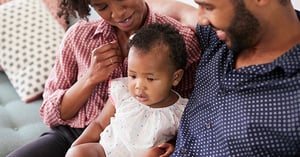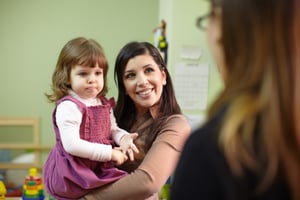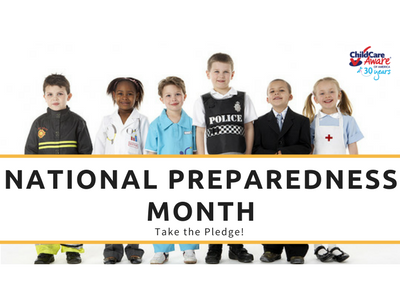 Every week in the United States, nearly 11 million children younger than age five are in some type of child care arrangement, many of whom spend 30 hours or more per week in out of home care. Over 100,000 of Kansas children are served through Kansas early care programs. Early care and education settings are a critical extension of the family home with continuity between the two being of prime importance.
Every week in the United States, nearly 11 million children younger than age five are in some type of child care arrangement, many of whom spend 30 hours or more per week in out of home care. Over 100,000 of Kansas children are served through Kansas early care programs. Early care and education settings are a critical extension of the family home with continuity between the two being of prime importance.
Early care and education professionals and parents want what is best for the child both in and outside of the early care setting. Ongoing, intentional, and meaningful engagement with families is at the core of the bi-directional home to child care relationship and leads to shared goals that benefit the child. Good home-child care partnerships also benefit families; through them, parents and family members feel recognized for their expertise about their child and may be more interested collaborating with providers and programs. Effective family engagement also facilitates the safety, trust, encouragement, and caring that affect the well-being of both the child and the family.
Engagement with families benefits the early care workforce as well. Professionals feel more job satisfaction, experience greater alliances with families, and are more confident and open in their interactions. Established partnerships with families also make it easier for early care professionals to have conversations involving uncomfortable or challenging topics or issues, such as concerns about development or behavior.
Family Engagement – What is it?
 “Family Engagement” is a buzzword that has been floating around for some time in the Head Start and Early Head Start sectors and recently has become more in vogue in the early care and education field as a whole (i.e., the rest of the child care system). It’s not that family engagement hasn’t been occurring all along in mainstream early care and education programs. Rather, recent early care and education policy updates (e.g., The Child Care and Development Block Grant Reauthorization in 2014) and mounting evidence of the beneficial impact of family engagement on children (and families) from birth through school age has made heads turn more directly toward it.
“Family Engagement” is a buzzword that has been floating around for some time in the Head Start and Early Head Start sectors and recently has become more in vogue in the early care and education field as a whole (i.e., the rest of the child care system). It’s not that family engagement hasn’t been occurring all along in mainstream early care and education programs. Rather, recent early care and education policy updates (e.g., The Child Care and Development Block Grant Reauthorization in 2014) and mounting evidence of the beneficial impact of family engagement on children (and families) from birth through school age has made heads turn more directly toward it.
So…you may be asking, WHAT IS family engagement and how can families and early care and education professionals (in all positions throughout the child care program operation, such as direct care and education providers, administrative staff, specialists, etc.) DO IT?
Think of family engagement as an interactive process that brings together parents and other family members, children, and early childhood professionals at all levels. Everyone works together in partnership in service of children’s learning, healthy development, and wellbeing. With families in the driver’s seat, families and program personnel share their unique knowledge of the individual children they teach and care for, and the contexts and communities in which they live.
Key Features of Family Engagement
The National Center on Parent, Family and Community Engagement (NCPFCE), a federal early care and education training and technical assistance center, posits the following as key values of quality family engagement:
- Cultural & Linguistic Responsiveness – the program reflects the diversity of families (including but not limited to: gender, employment/occupation, disability status, culture, language, income, age, race/ethnicity, etc.).
- Equity – which may be be described as the elimination of privilege, oppression, disparities, and disadvantage.
- Inclusiveness – every childtruly is included and the individual needs of each child are considered and valued
- Positive & Goal Oriented Relationships – program staff create and sustain relationships with families through positive communication that is responsive to families’ preferences. Program staff also collaborate with families to identify family and child goals, develop action plans, and jointly make decisions about how to achieve goals.
The NCPFCE also recommends that family engagement efforts be Systemic and Comprehensive. Think of family engagement as being baked INTO the cake, not just as icing on the top of the cake that looks nice. It is best when family engagement is integrated throughout all aspects of programming.
How can families and early care professionals be “engaged” with one another? What does this look like?
There are four key program areas to consider during the development and implementation of systemic and comprehensive family engagement plan. When considering quality family engagement tactics to employ in programming, integrate of each of the family engagement values noted above (i.e., cultural and linguistic responsiveness, equity, inclusiveness and positive & goal oriented relationships). For comprehensiveness, use the four program areas noted below as a roadmap for planning efforts (professionals) or as a guide for key aspects of the child care program where you should be engaged (families). Examples of family engagement practices are noted following each program area:
Communication
- Multiple, different ways to communicate are offered to families with an effort to match family communication preferences with daily communication practice
- Information is provided to families related to early childhood development, including social and emotional and physical health, and how to track and support child progress—in culturally & linguistically responsive ways
- Engage families around their child’s screening information
- Families are engaged in an authentic manner and time is made for meaningful conversations
Family Needs & Feedback Inform Program
- Opportunities for regular feedback is encouraged with a system put in place for family feedback. Family input is acknowledged and used to inform program planning and policies
- Programs are adapted to meet the needs of children and families
- Hiring practices of staff and volunteers reflect diverse backgrounds of families served
Collaborative Activities with Families
- Opportunities are provided for families to socialize and form lasting relationships with one another.
- Built in opportunities exist for families and staff to interact meaningfully and learn from one another
- The child care program offers and encourages family volunteer opportunities that match family strengths, interests and skills
Community Resources & Family Support
- Families are provided with information about child care options as their child’s needs dictate or family circumstances necessitate a child care placement transition
- Coordination occurs with child and family serving agencies to support overall family wellbeing (e.g., financial, health care, health insurance, or mental health services)
- Partnerships are established with public agencies and private entities to support linkages to comprehensive services for families (e.g., community health center, early literacy through library partnerships, domestic violence shelters, community-based organizations that serve the needs of families experiencing unstable housing)
The children served through early care and education programs carry with them an evolving and rich background reflective of their family. Early care and education programs that partner with families, engage families as programmatic drivers, employ positive, two-way communication strategies, and make efforts to reflect the culture, values and preferences of families within their program will reap many rewards in the form of maximized child and family outcomes. Family engagement strategies form the basis of partnerships that serve the needs of children, improve quality of care, and support family well-being.
Early care and education professionals - take an inventory of your family engagement practices. Is there room to expand your efforts by thoughtfully integrating more core family engagement values into your programming and practices?
Families – what do you want your child care provider to know about you and your family? What are ways you can communicate your ideas with your child care provider or share your culture with other children in the program?
The family and early care & education partnership is critical to the success of child care programs and family success!
This article was originally published in Kansas Magazine's Fall/Winter 2017 issue.





